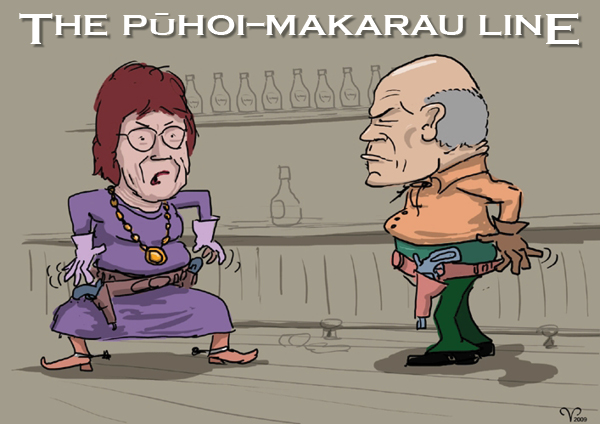Notion to exclude Mahurangi uncalled-for

P Dubya: ‘Mu gobsmackin’ refusal to remain’n yur dirty region’s no gobsmack’d reason to run me outta yur dirty region.’ cartoon Majorlook Productions
Preposterous—the word Mahurangi Action founder John Male impassionedly used.
He was describing a proposal whereby 80 copies of the 416-page Jade River: A History of the Mahurangi be photocopied to nominally discharge the undertaking to publish given to its terminally ill author, Dr Ronald Locker, before he died.
John Male was the book’s editor, coordinating the editing contributions of a number of volunteers. But the work had taken seven long years to complete, and had attracted some detractors, one of whom considered he enjoyed the executive authority to dump the project.
In spite of by then approaching his final year, John attended a do-or-die meeting, where the photocopy expedient ultimately failed to attract a single supporter. The history was professionally offset-printed and nearly 2000 are now cherished possessions—the first edition of 1000 sold out in six months.
Over the years, a number of copies have been presented to policy-makers. The purpose is partly to impress the recipient that Friends of the Mahurangi is a mature and reasonable organisation. But of particular relevance to city-based functionaries, is the vivid picture Locker paints of the historically close relationship of the Mahurangi and Auckland, particularly during the steamboat era.
Some (typically recent escapees) love to hate or mock the metropolis. Presumably it was these people Rodney District Council thought it could count on to back its bid to become a separate unitary authority.
But apart from lacking mandate, the rationale for removing Rodney district from the region was uniformed—the need for region-based decision-making was formalised in 1954, with the establishment of the Auckland Regional Planning Authority. What was not sustainable, and long overdue for resolution, was the degree of overlap in planning responsibility.
Aside from sedimentation and sea level rise, the signal threat to the Mahurangi–Matakana–Leigh is Whangaparāoa-isation—creeping urbanisation. The demand for coastal, out of the city boltholes is insatiable, albeit understandable. The challenge is to plan to ensure that such development doesn’t destroy the landscape of outstanding natural beauty that is the area’s indisputable attraction.
By far the biggest audience of Mahurangi’s beauty are residents of the wider region. (And increasingly nearby: The most common address on the Mahurangi Regatta certificates, belatedly mailed out last month, was Whangaparāoa.)
It passionately matters to its city-based audience that planning provisions are in place to protect the landscape; would it remotely matter to the people of Whangārei?
The writing is on the wall for regional councils, including Northland’s. The two northern mayors are already braying for their own unitary authorities. But, as proved to be the case for Rodney’s mayor, they should be careful of what they wish for—a single Northland unitary authority is a more rational scenario that one each for the Far North, Whangārei and Kaipara.
Regardless of how soon Northland governance is addressed, placing the populous Auckland-oriented district of Mahurangi–Matakana–Leigh at the extreme end of Northland is irrational. The Labour Party’s minority report addresses most of the issue, succinctly:
The Royal Commission argued persuasively that the regional boundary must be far enough from the metropolitan urban limit to ensure that non-conforming development does not leapfrog the limit to an area beyond the planning restrictions, thus defeating the purpose of the urban limit. Labour believes that Auckland’s regional parks should stay within Auckland, and that transferring Auckland’s prized northern beaches to the Kaipara District Council would be unlikely to afford them the protection from development they need.
Auckland Regional Council councillor Christine Rose, who has represented Rodney at a district and regional level for 14 years, said the decision to sever most of the district’s landmass from greater Auckland defied logic.
It will have dangerous effects on Rodney’s rural character, growth management, ecology, and the quality of landscapes and water. Gone will be the opportunity to deal with growth and infrastructure requirements with the benefits of a regional perspective and economies of scale.
The regional council’s media release states:
The Rodney district has experienced massive growth because of its proximity to metropolitan Auckland, and will continue to be a pressure point. Growth in Rodney needs to be managed in conjunction with Auckland’s because of the direct environmental consequences for catchment management, natural and cultural heritage, landscape protection and species recovery.
In contrast to the, in some places, strident objections to a Waiwera boundary, Saturday’s New Zealand Herald editorial categorises that, and the dismissal of Māori seats, as ‘a short-sighted decision will probably have to be repaired in time.’
Locals are in no mood to accept a Waiwera boundary and trust it will be tweaked at some future opportunity, as the editorial suggests.
Nor should they: The new Auckland governance arrangements will be hugely disruptive, and for years until fully bedded in—large-scale local government reform is inherently and unavoidably disruptive. To upend the Kaipara district to boot, is unnecessary.
The notion that Mahurangi–Matakana–Leigh is part of the Northland region community of interest is, in a wordpreposterous c.1540, from L. præposterus ‘absurd, contrary to nature,’ lit. ‘before-behind’ (cf. topsy-turvy, cart before the horse), from præ ‘before’ + posterus—subsequent, preposterous.
A public meeting is planned, and an invitation has been sent to the Ministry for Local Government, Rodney Hide. It will be very heavily attended if readership of the Mahurangi Magazine is any indication—the subject is bringing more visitors to the website than are seen even during the annual Mahurangi Regatta spike.
And it is not too late for Mayor Webster to admit that the unitary authority crusade was misguided, to unconditionally support the grass roots revolt against a Pūhoi to Makarau river mouths line, and to work for the adoption of the best governance arrangements that can be devised for the region.
